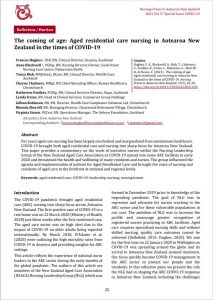The Nursing Leadership Group (NLG) is the recognised voice of aged care nursing. The following article written by the NLG which includes HCSL’s very own Director, Gillian Robinson BN, RN has been published in the Nursing Praxis – Journal of Professional Nursing Special Issue: Nursing response to COVID-19 in Aotearoa New Zealand
The coming of age: Aged residential care nursing in Aotearoa New Zealand in the times of COVID-19
For years aged care nursing has been largely overlooked and marginalised from mainstream healthcare. COVID-19 brought both aged residential care and nursing into sharp focus for Aotearoa New Zealand. This paper provides a commentary on the work of executive nurses within the Nursing Leadership Group of the New Zealand Aged Care Association as COVID-19 spread into some ARC facilities in early 2020 and threatened the health and wellbeing of many residents and nurses. The group influenced the agenda and implementation of policies for Aged Residential Care and brought the voice of nursing and residents of aged care to the forefront at national and regional levels.
CLICK BELOW TO DOWNLOAD THE FULL ARTICLE.

Frances Hughes, PhD, RN, Clinical Director, Oceania, Auckland
Anna Blackwell , PGDip, RN, Nursing Director/Owner, Cook Street Nursing Care Centre, Palmerston North
Tanya Bish, MN(Hons), BCom, RN, Clinical Director, Metlife Care, Auckland
Cheyne Chalmers, MMgt, RN, Chief Operating Officer, Ryman Healthcare, Christchurch
Katherine Foulkes, PGDip, RN, Clinical Services Director, Bupa, Auckland
Lynda Irvine, RN, Head of Clinical Services, Summerset Group Holdings Ltd, Auckland
Gillian Robinson, BN, RN, Director, Health Care Compliance Solutions Ltd, Christchurch
Rhonda Sherriff, RN, Managing Director, Chatswood Retirement Village, Christchurch
Virginia Sisson, PGCert, RN, Operations Manager, The Selwyn Foundation, Auckland
Reference: Hughes, F. A., Blackwell, A., Bish, T., Chalmers, C., Foulkes, K., Irvine, L., Robinson, G., Sherriff, R., & Sisson, V. (2021). The coming of age: Aged residential care nursing in Aotearoa New Zealand in the times of COVID-19. Nursing Praxis in Aotearoa New Zealand, 37(3), 25-29.

 Workplace culture is a term bandied around a lot but what does it actually mean and how can it be measured? When I ask staff at facilities during training sessions what they see their point of difference is, they frequently reply saying ‘we’re friendly’, or ‘we care’ or ‘we provide a homely environment’. While these are all nice to have, they would actually be expected as a basic standard. They are not specific and not anything different to the care facility down the road.
Workplace culture is a term bandied around a lot but what does it actually mean and how can it be measured? When I ask staff at facilities during training sessions what they see their point of difference is, they frequently reply saying ‘we’re friendly’, or ‘we care’ or ‘we provide a homely environment’. While these are all nice to have, they would actually be expected as a basic standard. They are not specific and not anything different to the care facility down the road.
